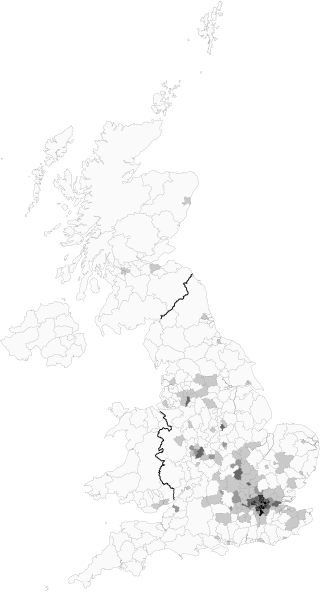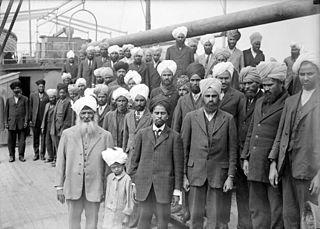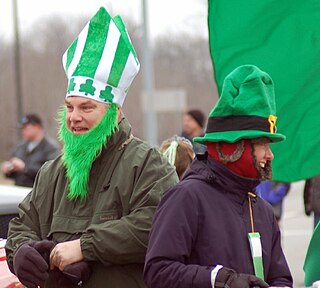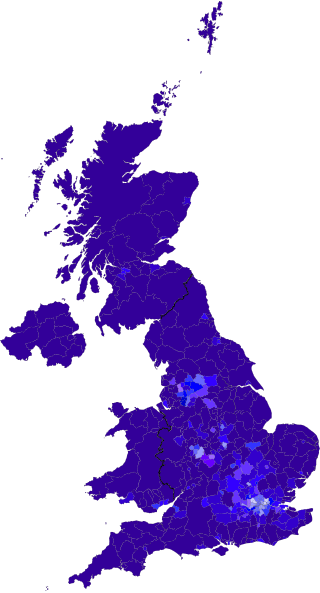Related Research Articles
Black is a racialized classification of people, usually a political and skin color-based category for specific populations with a mid- to dark brown complexion. Not all people considered "black" have dark skin; in certain countries, often in socially based systems of racial classification in the Western world, the term "black" is used to describe persons who are perceived as dark-skinned compared to other populations. It is most commonly used for people of sub-Saharan African ancestry, Indigenous Australians and Melanesians, though it has been applied in many contexts to other groups, and is no indicator of any close ancestral relationship whatsoever. Indigenous African societies do not use the term black as a racial identity outside of influences brought by Western cultures.
A West Indian is a native or inhabitant of the West Indies. In the 1597 Oxford English Dictionary (OED), the term West Indian initially described the indigenous inhabitants of the West Indies, by 1661 the term defined "an inhabitant or native of the West Indies, of European origin or descent." In the 1950s, coinciding with decolonization and the arrival of Afro-Caribbean migrants in the United Kingdom, West Indian referred to those who were Black. Inclusively, in 1961 all inhabitants of the West Indies Federation were termed West Indian regardless of their descent, besides West indian Indo-Caribbean people sometimes also use the term East Indian West Indian. The OED now defines it simply as a citizen of any West Indies nation. Some West Indian people reserve this term for citizens or natives of the British West Indies only, to the exclusion of not just the Hispanophones, but also French and Dutch West Indians.
The term "minority group" has different usages, depending on the context. According to its common usage, the term minority group can simply be understood in terms of demographic sizes within a population: i.e. a group in society with the least number of individuals, or less than half, is a "minority". Usually a minority group is disempowered relative to the majority, and that characteristic lends itself to different applications of the term minority.

Half-caste is a term used for individuals of multiracial descent. The word caste is borrowed from the Portuguese or Spanish word casta, meaning race. Terms such as half-caste, caste, quarter-caste and mix-breed were used by colonial officials in the British Empire during their classification of indigenous populations, and in Australia used during the Australian government's pursuit of a policy of assimilation. In Latin America, the equivalent term for half-castes was Cholo and Zambo. Some people now consider the term offensive.
The term "person of color" is primarily used to describe any person who is not considered "white". In its current meaning, the term originated in, and is primarily associated with, the United States; however, since the 2010s, it has been adopted elsewhere in the Anglosphere, including relatively limited usage in the United Kingdom, Canada, Australia, Ireland, South Africa, and Singapore.
The term model minority refers to a minority group, defined by factors such as ethnicity, race, or religion, whose members are perceived to be achieving a higher socioeconomic status in comparison to the overall population average. Consequently, these groups are often regarded as a role model or reference group for comparison to external groups (outgroups). This success is typically assessed through metrics including educational attainment, representation within managerial and professional occupations, household income, and various other socioeconomic indicators such as criminal activity and strong family and marital stability. The prominent association of the model minority concept is with Asian Americans within the United States. Additionally, analogous concepts of classism have been observed in numerous European countries, leading to the stereotyping of specific ethnic groups.

The United Kingdom is an ethnically diverse society. The largest ethnic group in the United Kingdom is White British, followed by Asian British. Ethnicity in the United Kingdom is formally recorded at the national level through a census. The 2011 United Kingdom census recorded a reduced share of White British people in the United Kingdom from the previous 2001 United Kingdom census. Factors that are contributing to the growth of minority populations are varied in nature, including differing birth rates and Immigration.
Covert racism is a form of racial discrimination that is disguised and subtle, rather than public or obvious. Concealed in the fabric of society, covert racism discriminates against individuals through often evasive or seemingly passive methods. Covert, racially biased decisions are often hidden or rationalized with an explanation that society is more willing to accept. These racial biases cause a variety of problems that serve to empower the suppressors while diminishing the rights and powers of the oppressed. Covert racism often works subliminally, and much of the discrimination is done subconsciously.

Black British people are a multi-ethnic group of British people of Sub-Saharan African or Afro-Caribbean descent. The term Black British developed in the 1950s, referring to the Black British West Indian people from the former Caribbean British colonies in the West Indies, sometimes referred to as the Windrush Generation, and Black British people descending from Africa.
Racialization or ethnicization is a sociological concept used to describe the intent and processes by which ethnic or racial identities are systematically constructed within a society. Constructs for racialization are centered on erroneous generalizations about racial aspects of distinct groups, leading to the denial of equal societal engagement. It is a fallacy of groupism and a process of racial dominance that has lasting harmful or damaging outcomes for racialized groups. An associated term is self-racialization, which refers to the practice by dominant groups to justify and defend their dominant status or to deny its existence. Individually, self-racialization may not be consistent throughout one's lifetime.

Stereotypes of South Asians consist of various generalized beliefs about individuals from South Asia which derive from the region's history and interaction with other cultures and peoples. These stereotypes are often rooted in orientalism, xenophobia and racism and date back to the history of European colonialism and imperialism in South Asia during the 18th and 19th centuries along with the immigration of South Asians to the English-speaking world in the 20th century. According to academics Omar Rahman, David Pollock and John Berry, such stereotypes, which have been primarily propagated through popular culture, have played a major role in hindering the process of acculturation for South Asian immigrants in Western nations.
Internalized racism is a form of internalized oppression, defined by sociologist Karen D. Pyke as the "internalization of racial oppression by the racially subordinated." In her study The Psychology of Racism, Robin Nicole Johnson emphasizes that internalized racism involves both "conscious and unconscious acceptance of a racial hierarchy in which a presumed superior race are consistently ranked above other races. These definitions encompass a wide range of instances, including, but not limited to, belief in negative stereotypes, adaptations to cultural standards, and thinking that supports the status quo.
A number of different systems of classification of ethnicity in the United Kingdom exist. These schemata have been the subject of debate, including about the nature of ethnicity, how or whether it can be categorised, and the relationship between ethnicity, race, and nationality.
Second-generation immigrants in the United States are individuals born and raised in the United States who have at least one foreign-born parent. Although the term is an oxymoron which is often used ambiguously, this definition is cited by major research centers including the United States Census Bureau and the Pew Research Center.

In sociology, symbolic ethnicity is a nostalgic allegiance to, love for, and pride in a cultural tradition that can be felt and lived without having to be incorporated to the person's everyday behavior; as such, a symbolic ethnic identity usually is composed of images from mass communications media.

Racism in the United Kingdom has a long history and includes structural discrimination and hostile attitudes against various ethnic minorities. The extent and the targets have varied over time. It has resulted in cases of discrimination, riots and racially motivated murders.

Leicester, England is an ethnically and culturally diverse city. It is the thirteenth most populous city in the United Kingdom.

White people in the United Kingdom are a multi-ethnic group consisting of indigenous and European UK residents who identify as and are perceived to be 'white people'. White people constitute the historical and current majority of the people living in the United Kingdom, with 83.0% of the population identifying as white in the 2021 United Kingdom census.
Dr Diana Yeh is a British Chinese sociologist, writer, curator, arts worker, and a prominent social and political activist in the United Kingdom. She is regarded as a leading expert on the history of British Chinese artists, and on racism and anti-racism, particularly in relation to Chinese diasporas. Yeh is a regular commentator on these issues, appearing frequently in interviews for international's news outlets.
"Global majority" is a collective term for people of Indigenous, African, Asian, or Latin American descent, who constitute approximately 85 percent of the global population. It has been used as an alternative to terms which are seen as racialized like "ethnic minority" and "person of color" (POC), or more regional terms like "visible minority" in Canada and "Black, Asian and Minority Ethnic" (BAME) in the United Kingdom. It roughly corresponds to people whose heritage can be traced back to nations of the Global South.
References
- 1 2 Mohdin, Aamna (3 March 2018). ""Political blackness": a very British concept with a complex history". Quartz.
- 1 2 3 Appiah, Kwame Anthony (7 October 2020). "What We Can Learn From the Rise and Fall of 'Political Blackness'". The New York Times. Archived from the original on 8 October 2020.
- ↑ Modood, Tariq (1994). "Political blackness and British Asians". Sociology. 28 (4): 859–876. doi:10.1177/0038038594028004004. ISSN 0038-0385. S2CID 143869991.
- ↑ Andrews, Kehinde (September 2016). "The problem of political blackness: lessons from the Black Supplementary School Movement" (PDF). Ethnic and Racial Studies. 39 (11): 2060–2078. doi:10.1080/01419870.2015.1131314. S2CID 147057939.
- ↑ Batty, David (26 October 2016). "Student union promotes Black History Month with Zayn Malik picture". The Guardian.
- ↑ Alexander, Claire (3 May 2018). "Breaking black: the death of ethnic and racial studies in Britain". Ethnic and Racial Studies. 41 (6): 1034–1054. doi: 10.1080/01419870.2018.1409902 . ISSN 0141-9870.